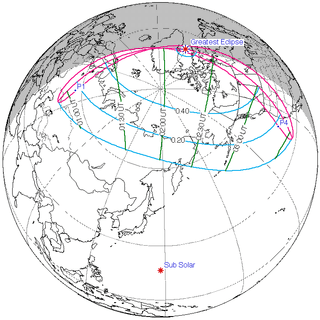Solar eclipse of July 31, 2000
| Solar eclipse of July 31, 2000 | |
|---|---|
 Map | |
| Type of eclipse | |
| Nature | Partial |
| Gamma | 1.2166 |
| Magnitude | 0.6034 |
| Maximum eclipse | |
| Coordinates | 69°30′N 59°54′W / 69.5°N 59.9°W |
| Times (UTC) | |
| Greatest eclipse | 2:14:08 |
| References | |
| Saros | 155 (5 of 71) |
| Catalog # (SE5000) | 9508 |
A partial solar eclipse occurred on July 31, 2000. A solar eclipse occurs when the Moon passes between Earth and the Sun, thereby totally or partly obscuring the image of the Sun for a viewer on Earth. A partial solar eclipse occurs in the polar regions of the Earth when the center of the Moon's shadow misses the Earth. It was visible from northern Russia, northeastern Scandinavia, northern Greenland, western Canada, northwestern United States.
Images

Related eclipses
Solar eclipses 1997-2000
Each member in a semester series of solar eclipses repeats approximately every 177 days and 4 hours (a semester) at alternating nodes of the Moon's orbit.
| Solar eclipse series sets from 1997 to 2000 | ||||||
|---|---|---|---|---|---|---|
| Descending node | Ascending node | |||||
| Saros | Map | Saros | Map | |||
120 Chita, Russia | March 9, 1997 Total |
125 | September 2, 1997 Partial | |||
| 130 | February 26, 1998 Total |
135 | August 22, 1998 Annular | |||
| 140 | February 16, 1999 Annular |
145 Totality from France | August 11, 1999 Total | |||
| 150 | February 5, 2000 Partial |
155 | July 31, 2000 Partial | |||
| Partial solar eclipses on July 1, 2000 and December 25, 2000 occur in the next lunar year eclipse set. | ||||||
Metonic series
The metonic series repeats eclipses every 19 years (6939.69 days), lasting about 5 cycles. Eclipses occur in nearly the same calendar date. In addition the octon subseries repeats 1/5 of that or every 3.8 years (1387.94 days).
| 21 eclipse events between July 31, 1924 and July 31, 2000 | ||||
|---|---|---|---|---|
| July 31-Aug 1 | May 19-20 | March 7 | December 24-25 | October 12 |
| 115 | 117 | 119 | 121 | 123 |
 July 31, 1924 |
 May 19, 1928 |
 March 7, 1932 |
 December 25, 1935 |
 October 12, 1939 |
| 125 | 127 | 129 | 131 | 133 |
 August 1, 1943 |
 May 20, 1947 |
 March 7, 1951 |
 December 25, 1954 |
 October 12, 1958 |
| 135 | 137 | 139 | 141 | 143 |
 July 31, 1962 |
 May 20, 1966 |
 March 7, 1970 |
 December 24, 1973 |
 October 12, 1977 |
| 145 | 147 | 149 | 151 | 153 |
 July 31, 1981 |
 May 19, 1985 |
 March 7, 1989 |
 December 24, 1992 |
 October 12, 1996 |
| 155 | ||||
 July 31, 2000 | ||||
Notes
References
- Earth visibility chart and eclipse statistics Eclipse Predictions by Fred Espenak, NASA/GSFC
- Partial Solar Eclipse: July 30/31, 2000
- www.mreclipse.com Partial Solar Eclipse of 2000 July 30/31 by Fred Espenak (Spokane, WA)
| Wikimedia Commons has media related to Solar eclipse of 2000 July 31. |
